2016 JEEP GRAND CHEROKEE tow
[x] Cancel search: towPage 475 of 723
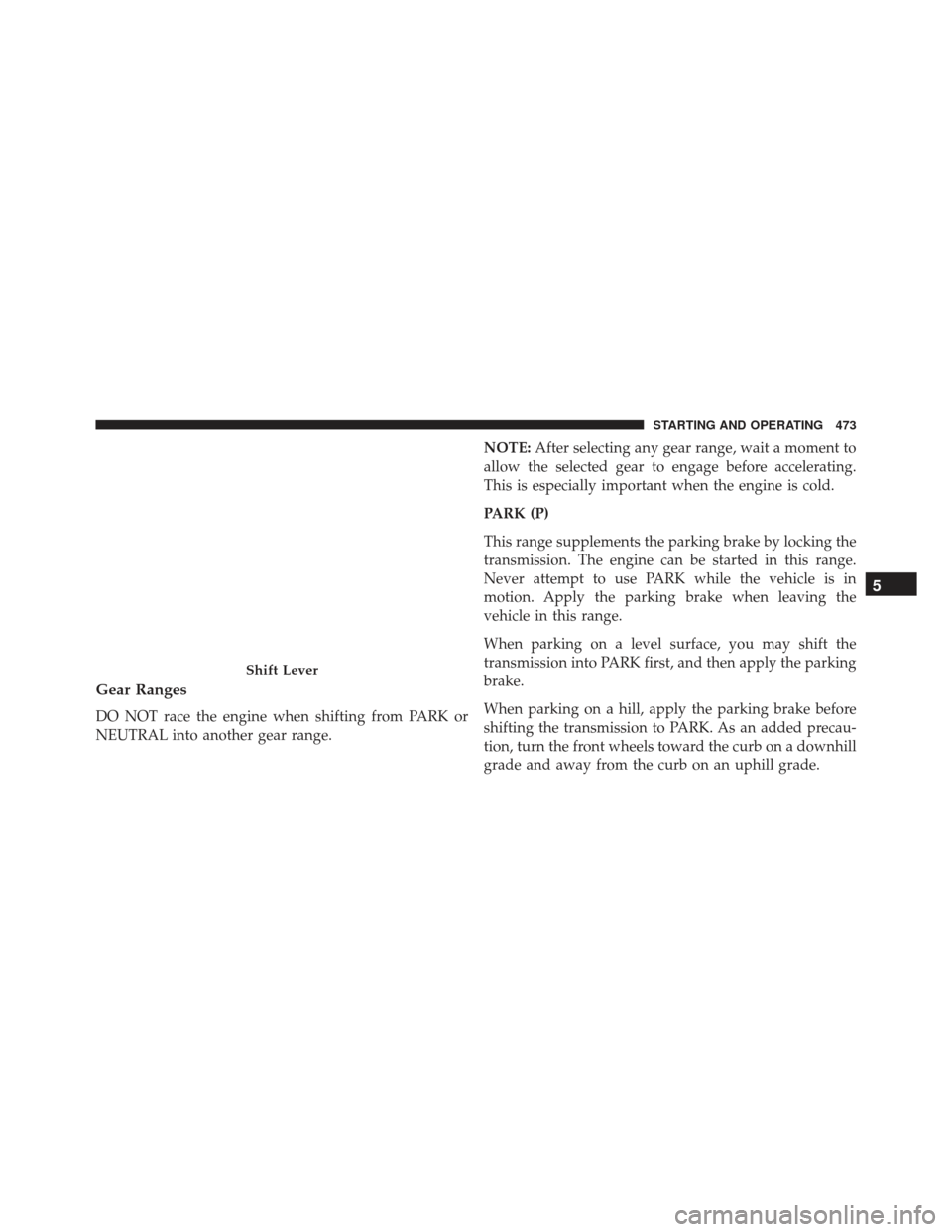
Gear Ranges
DO NOT race the engine when shifting from PARK or
NEUTRAL into another gear range.NOTE:
After selecting any gear range, wait a moment to
allow the selected gear to engage before accelerating.
This is especially important when the engine is cold.
PARK (P)
This range supplements the parking brake by locking the
transmission. The engine can be started in this range.
Never attempt to use PARK while the vehicle is in
motion. Apply the parking brake when leaving the
vehicle in this range.
When parking on a level surface, you may shift the
transmission into PARK first, and then apply the parking
brake.
When parking on a hill, apply the parking brake before
shifting the transmission to PARK. As an added precau-
tion, turn the front wheels toward the curb on a downhill
grade and away from the curb on an uphill grade.
Shift Lever
5
STARTING AND OPERATING 473
Page 478 of 723

•With brake pedal released, verify that the gear selector
will not move out of PARK.
NOTE: If the gear selector cannot be moved to the
PARK, REVERSE, or NEUTRAL position (when pushed
forward) it is probably in the AutoStick (+/-) position
(beside the DRIVE position). In AutoStick mode, the
transmission gear (1, 2, 3, etc.) is displayed in the
instrument cluster. Move the gear selector to the right
(into the DRIVE [D] position) for access to PARK, RE-
VERSE, and NEUTRAL.
REVERSE (R)
This range is for moving the vehicle backward. Shift into
REVERSE only after the vehicle has come to a complete
stop.
NEUTRAL (N)
Use this range when the vehicle is standing for prolonged
periods with the engine running. Apply the parking brake and shift the transmission into PARK if you must
leave the vehicle.
WARNING!
Do not coast in NEUTRAL and never turn off the
ignition to coast down a hill. These are unsafe
practices that limit your response to changing traffic
or road conditions. You might lose control of the
vehicle and have a collision.
CAUTION!
Towing the vehicle, coasting, or driving for any other
reason with the transmission in NEUTRAL can cause
severe transmission damage. Refer to “Recreational
Towing” in “Starting And Operating” and “Towing A
Disabled Vehicle” in “What To Do In Emergencies”
for further information.
476 STARTING AND OPERATING
Page 479 of 723
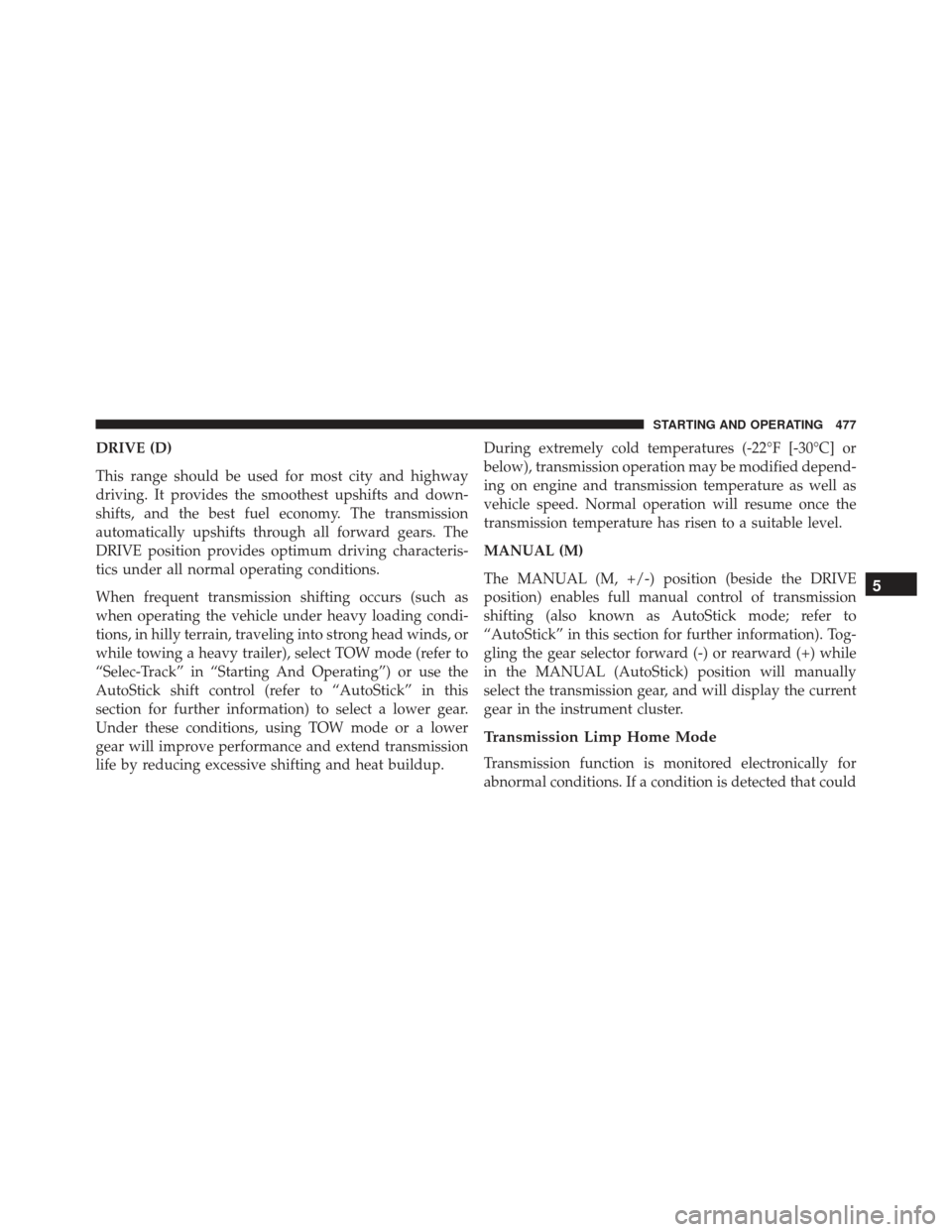
DRIVE (D)
This range should be used for most city and highway
driving. It provides the smoothest upshifts and down-
shifts, and the best fuel economy. The transmission
automatically upshifts through all forward gears. The
DRIVE position provides optimum driving characteris-
tics under all normal operating conditions.
When frequent transmission shifting occurs (such as
when operating the vehicle under heavy loading condi-
tions, in hilly terrain, traveling into strong head winds, or
while towing a heavy trailer), select TOW mode (refer to
“Selec-Track” in “Starting And Operating”) or use the
AutoStick shift control (refer to “AutoStick” in this
section for further information) to select a lower gear.
Under these conditions, using TOW mode or a lower
gear will improve performance and extend transmission
life by reducing excessive shifting and heat buildup.During extremely cold temperatures (-22°F [-30°C] or
below), transmission operation may be modified depend-
ing on engine and transmission temperature as well as
vehicle speed. Normal operation will resume once the
transmission temperature has risen to a suitable level.
MANUAL (M)
The MANUAL (M, +/-) position (beside the DRIVE
position) enables full manual control of transmission
shifting (also known as AutoStick mode; refer to
“AutoStick” in this section for further information). Tog-
gling the gear selector forward (-) or rearward (+) while
in the MANUAL (AutoStick) position will manually
select the transmission gear, and will display the current
gear in the instrument cluster.
Transmission Limp Home Mode
Transmission function is monitored electronically for
abnormal conditions. If a condition is detected that could
5
STARTING AND OPERATING 477
Page 481 of 723
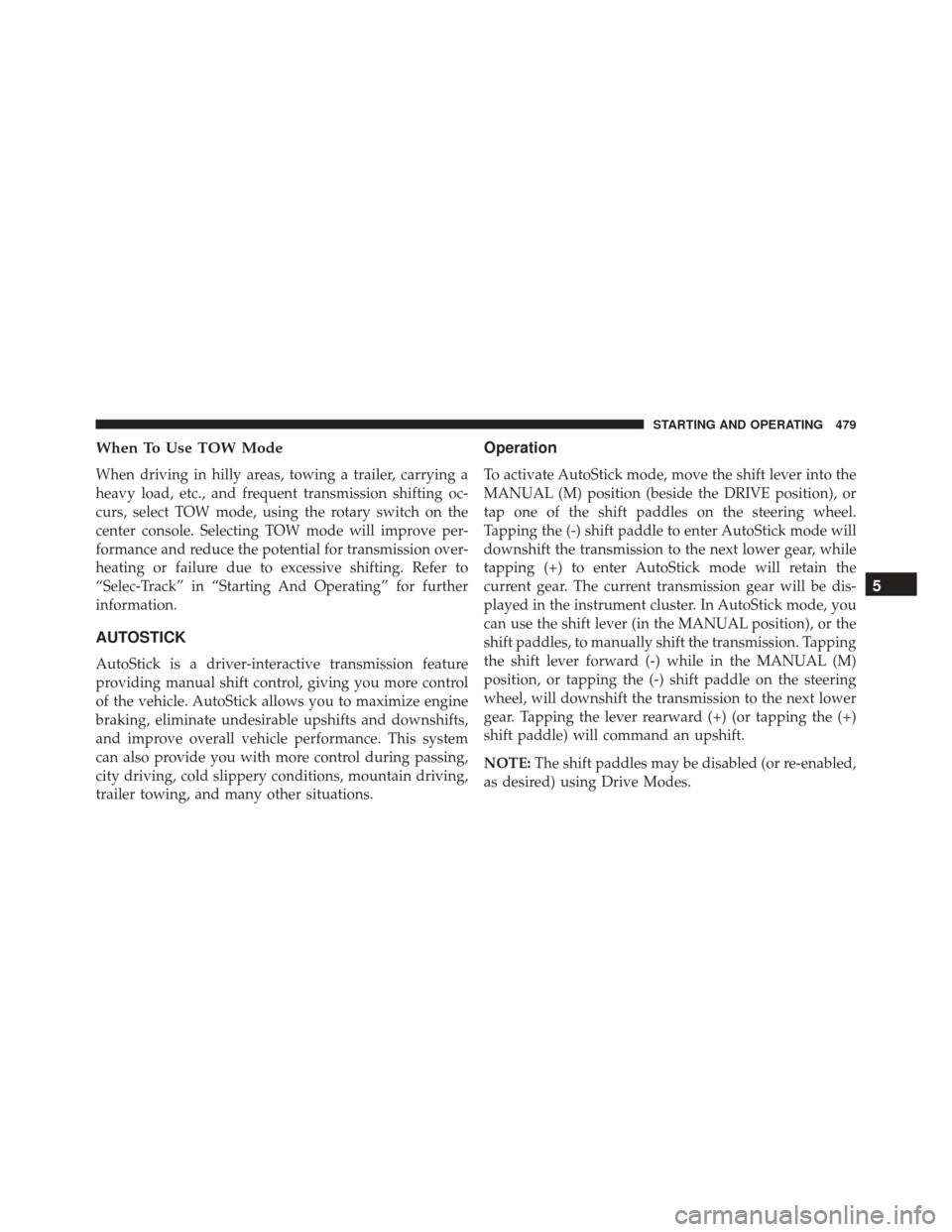
When To Use TOW Mode
When driving in hilly areas, towing a trailer, carrying a
heavy load, etc., and frequent transmission shifting oc-
curs, select TOW mode, using the rotary switch on the
center console. Selecting TOW mode will improve per-
formance and reduce the potential for transmission over-
heating or failure due to excessive shifting. Refer to
“Selec-Track” in “Starting And Operating” for further
information.
AUTOSTICK
AutoStick is a driver-interactive transmission feature
providing manual shift control, giving you more control
of the vehicle. AutoStick allows you to maximize engine
braking, eliminate undesirable upshifts and downshifts,
and improve overall vehicle performance. This system
can also provide you with more control during passing,
city driving, cold slippery conditions, mountain driving,
trailer towing, and many other situations.
Operation
To activate AutoStick mode, move the shift lever into the
MANUAL (M) position (beside the DRIVE position), or
tap one of the shift paddles on the steering wheel.
Tapping the (-) shift paddle to enter AutoStick mode will
downshift the transmission to the next lower gear, while
tapping (+) to enter AutoStick mode will retain the
current gear. The current transmission gear will be dis-
played in the instrument cluster. In AutoStick mode, you
can use the shift lever (in the MANUAL position), or the
shift paddles, to manually shift the transmission. Tapping
the shift lever forward (-) while in the MANUAL (M)
position, or tapping the (-) shift paddle on the steering
wheel, will downshift the transmission to the next lower
gear. Tapping the lever rearward (+) (or tapping the (+)
shift paddle) will command an upshift.
NOTE:The shift paddles may be disabled (or re-enabled,
as desired) using Drive Modes.
5
STARTING AND OPERATING 479
Page 484 of 723
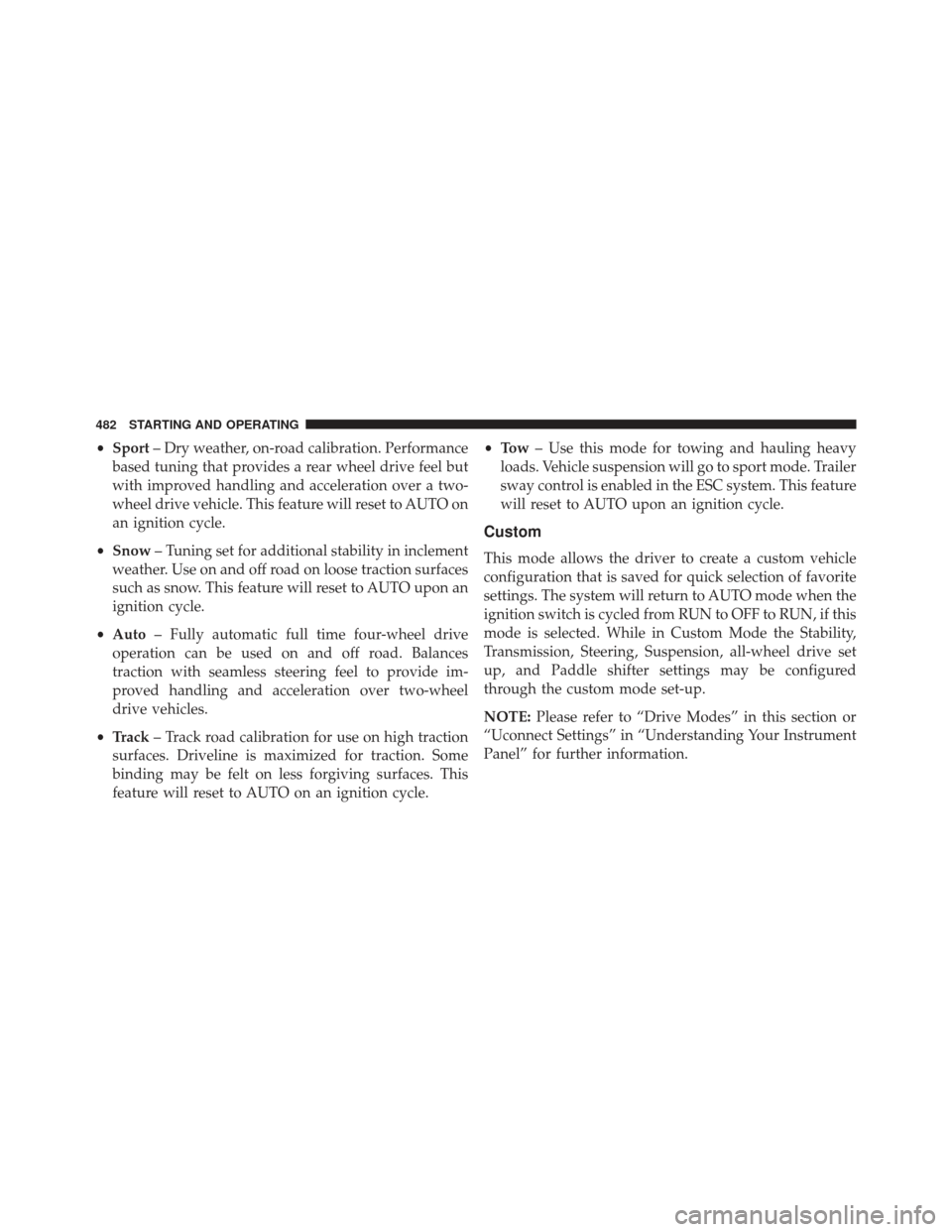
•Sport – Dry weather, on-road calibration. Performance
based tuning that provides a rear wheel drive feel but
with improved handling and acceleration over a two-
wheel drive vehicle. This feature will reset to AUTO on
an ignition cycle.
• Snow – Tuning set for additional stability in inclement
weather. Use on and off road on loose traction surfaces
such as snow. This feature will reset to AUTO upon an
ignition cycle.
• Auto – Fully automatic full time four-wheel drive
operation can be used on and off road. Balances
traction with seamless steering feel to provide im-
proved handling and acceleration over two-wheel
drive vehicles.
• Track – Track road calibration for use on high traction
surfaces. Driveline is maximized for traction. Some
binding may be felt on less forgiving surfaces. This
feature will reset to AUTO on an ignition cycle. •
To w – Use this mode for towing and hauling heavy
loads. Vehicle suspension will go to sport mode. Trailer
sway control is enabled in the ESC system. This feature
will reset to AUTO upon an ignition cycle.
Custom
This mode allows the driver to create a custom vehicle
configuration that is saved for quick selection of favorite
settings. The system will return to AUTO mode when the
ignition switch is cycled from RUN to OFF to RUN, if this
mode is selected. While in Custom Mode the Stability,
Transmission, Steering, Suspension, all-wheel drive set
up, and Paddle shifter settings may be configured
through the custom mode set-up.
NOTE: Please refer to “Drive Modes” in this section or
“Uconnect Settings” in “Understanding Your Instrument
Panel” for further information.
482 STARTING AND OPERATING
Page 485 of 723
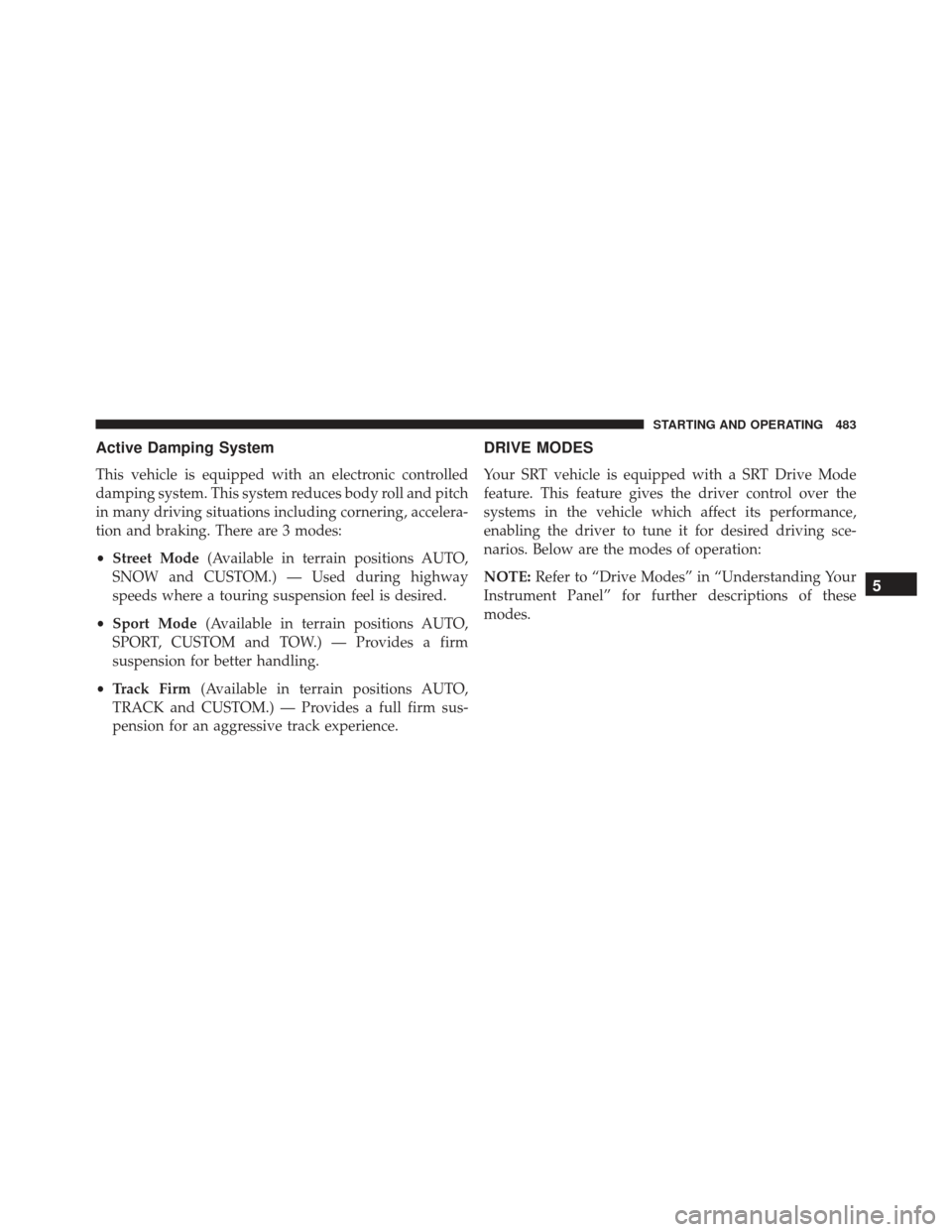
Active Damping System
This vehicle is equipped with an electronic controlled
damping system. This system reduces body roll and pitch
in many driving situations including cornering, accelera-
tion and braking. There are 3 modes:
•Street Mode (Available in terrain positions AUTO,
SNOW and CUSTOM.) — Used during highway
speeds where a touring suspension feel is desired.
• Sport Mode (Available in terrain positions AUTO,
SPORT, CUSTOM and TOW.) — Provides a firm
suspension for better handling.
• Track Firm (Available in terrain positions AUTO,
TRACK and CUSTOM.) — Provides a full firm sus-
pension for an aggressive track experience.
DRIVE MODES
Your SRT vehicle is equipped with a SRT Drive Mode
feature. This feature gives the driver control over the
systems in the vehicle which affect its performance,
enabling the driver to tune it for desired driving sce-
narios. Below are the modes of operation:
NOTE: Refer to “Drive Modes” in “Understanding Your
Instrument Panel” for further descriptions of these
modes.
5
STARTING AND OPERATING 483
Page 486 of 723
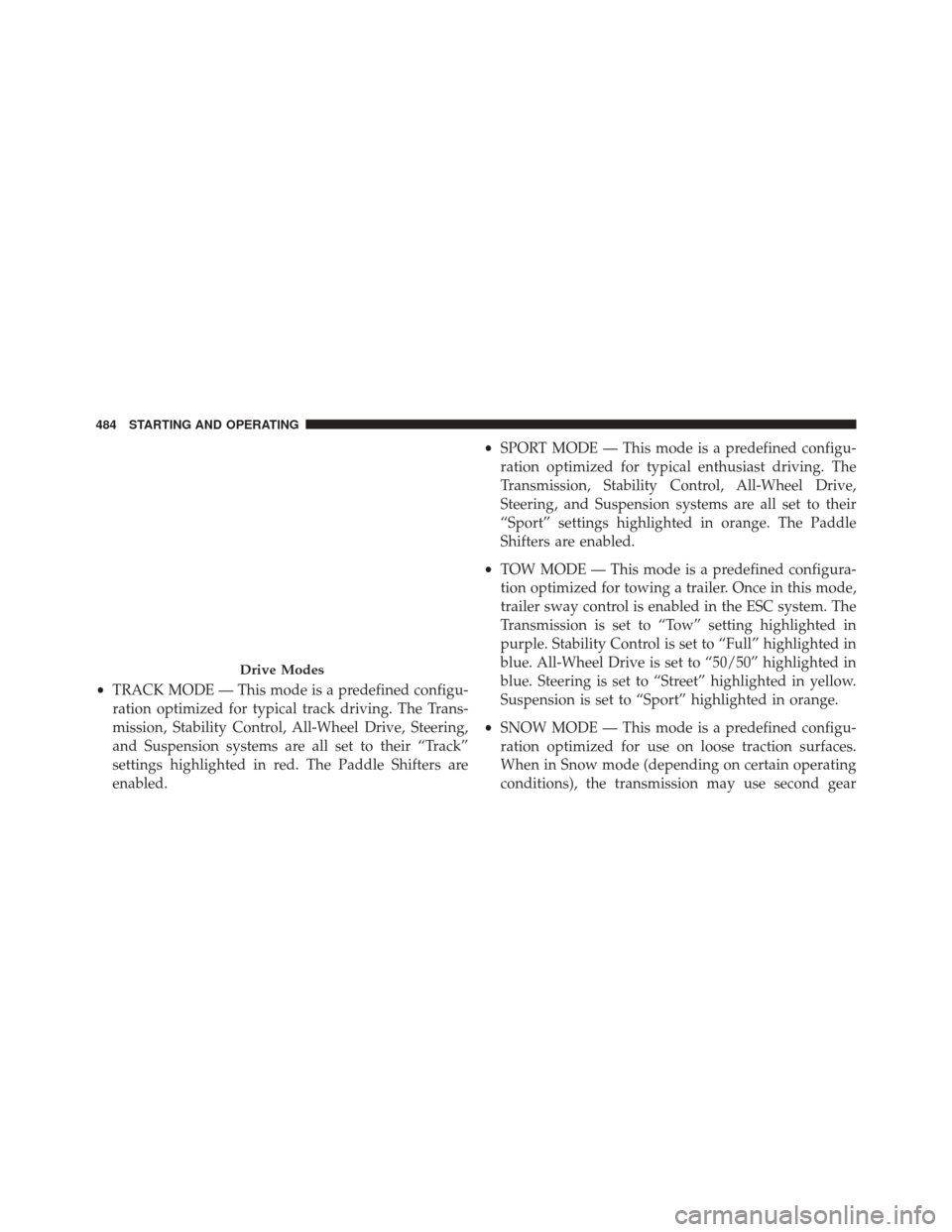
•TRACK MODE — This mode is a predefined configu-
ration optimized for typical track driving. The Trans-
mission, Stability Control, All-Wheel Drive, Steering,
and Suspension systems are all set to their “Track”
settings highlighted in red. The Paddle Shifters are
enabled. •
SPORT MODE — This mode is a predefined configu-
ration optimized for typical enthusiast driving. The
Transmission, Stability Control, All-Wheel Drive,
Steering, and Suspension systems are all set to their
“Sport” settings highlighted in orange. The Paddle
Shifters are enabled.
• TOW MODE — This mode is a predefined configura-
tion optimized for towing a trailer. Once in this mode,
trailer sway control is enabled in the ESC system. The
Transmission is set to “Tow” setting highlighted in
purple. Stability Control is set to “Full” highlighted in
blue. All-Wheel Drive is set to “50/50” highlighted in
blue. Steering is set to “Street” highlighted in yellow.
Suspension is set to “Sport” highlighted in orange.
• SNOW MODE — This mode is a predefined configu-
ration optimized for use on loose traction surfaces.
When in Snow mode (depending on certain operating
conditions), the transmission may use second gear
Drive Modes
484 STARTING AND OPERATING
Page 501 of 723
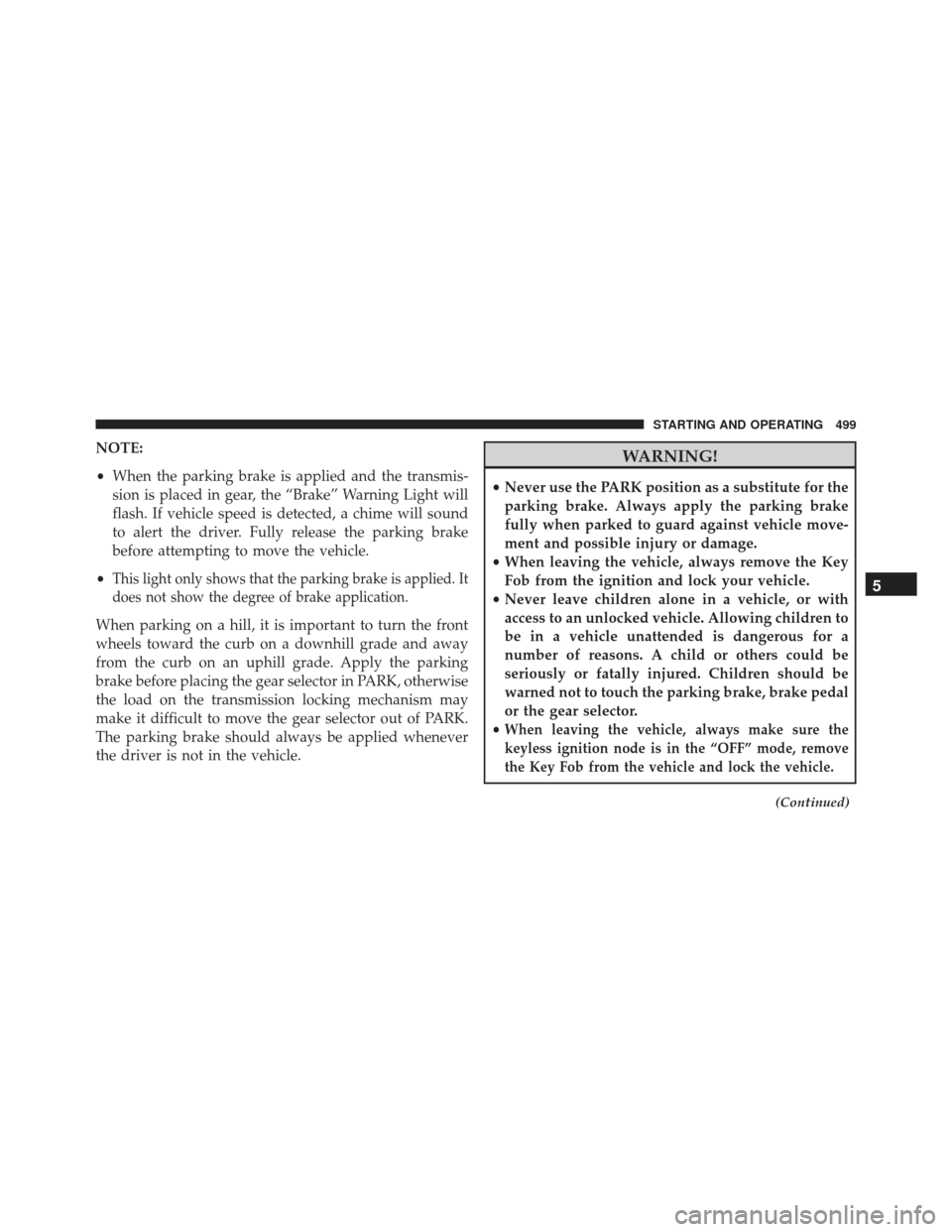
NOTE:
•When the parking brake is applied and the transmis-
sion is placed in gear, the “Brake” Warning Light will
flash. If vehicle speed is detected, a chime will sound
to alert the driver. Fully release the parking brake
before attempting to move the vehicle.
•
This light only shows that the parking brake is applied. It
does not show the degree of brake application.
When parking on a hill, it is important to turn the front
wheels toward the curb on a downhill grade and away
from the curb on an uphill grade. Apply the parking
brake before placing the gear selector in PARK, otherwise
the load on the transmission locking mechanism may
make it difficult to move the gear selector out of PARK.
The parking brake should always be applied whenever
the driver is not in the vehicle.
WARNING!
• Never use the PARK position as a substitute for the
parking brake. Always apply the parking brake
fully when parked to guard against vehicle move-
ment and possible injury or damage.
• When leaving the vehicle, always remove the Key
Fob from the ignition and lock your vehicle.
• Never leave children alone in a vehicle, or with
access to an unlocked vehicle. Allowing children to
be in a vehicle unattended is dangerous for a
number of reasons. A child or others could be
seriously or fatally injured. Children should be
warned not to touch the parking brake, brake pedal
or the gear selector.
•
When leaving the vehicle, always make sure the
keyless ignition node is in the “OFF” mode, remove
the Key Fob from the vehicle and lock the vehicle.
(Continued)
5
STARTING AND OPERATING 499